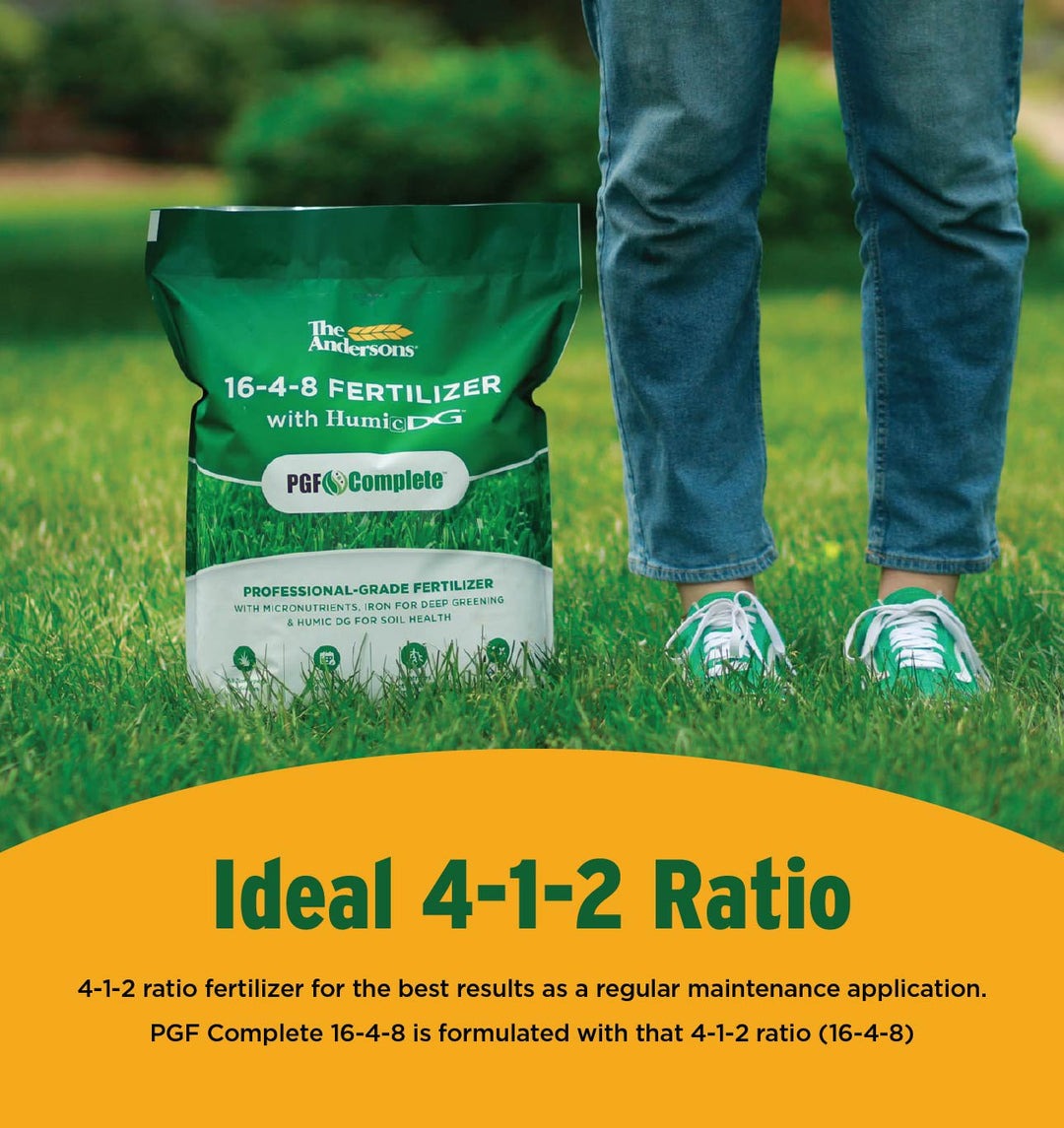4-1-2 fertilizer is a balanced nutrient blend formulated specifically to meet the needs of turfgrass and other lawn plants. The numbers in its name represent the ratio of the three primary macronutrients—nitrogen, phosphorus, and potassium (N-P-K). In this case, it contains four parts nitrogen, one part phosphorus, and two parts potassium. This ratio is considered ideal for lawns because it provides the right amount of nitrogen for lush green growth, a modest level of phosphorus for root development, and sufficient potassium to strengthen grass blades and improve stress tolerance.
Unlike fertilizers designed for flowering plants or crops, which often require higher phosphorus, lawns need more nitrogen to encourage dense, green leaf growth. The moderate potassium content supports overall plant health, helping grass withstand drought, heat, pests, and foot traffic. The lower phosphorus content is intentional because most established lawns already have adequate phosphorus levels, and excessive amounts can harm the environment by running off into waterways.
This type of fertilizer is commonly available in both granular and liquid forms. Granular 4-1-2 fertilizers are preferred for slow-release feeding, while liquid formulations are often used for quick green-up before special events or during active growing seasons. Because of its balanced formulation, it is widely recommended by turfgrass specialists for routine lawn maintenance.
Table of Contents
Why Nitrogen Dominates Lawn Fertilizer Formulas

Nitrogen is the most critical nutrient for lawns because it drives chlorophyll production, which directly influences how green and lush the grass appears. When nitrogen levels are sufficient, turfgrass produces thick, healthy blades that can outcompete weeds and recover quickly from mowing or foot traffic. The 4-1-2 fertilizer formula prioritizes nitrogen for this very reason, ensuring grass stays vibrant throughout the growing season.
However, too much nitrogen can lead to rapid growth that depletes soil nutrients and weakens root systems. Excessive nitrogen may also increase the risk of fungal diseases because dense, soft leaf tissue holds more moisture. The 4-1-2 ratio provides enough nitrogen to stimulate healthy growth without overwhelming the plant, making it safer for long-term lawn care.
Nitrogen in 4-1-2 fertilizers is often supplied in a combination of quick-release and slow-release forms. Quick-release nitrogen provides an immediate green-up, while slow-release nitrogen sustains growth over several weeks. This combination minimizes the need for frequent applications and reduces the risk of nutrient leaching.
The Role of Phosphorus in Lawn Development
Phosphorus plays a crucial role in root development, seedling establishment, and energy transfer within plants. However, most established lawns already contain sufficient phosphorus, especially if they have been fertilized regularly in the past. Adding too much phosphorus can be harmful because it tends to bind to soil particles and accumulate over time, eventually running off into streams and lakes during heavy rainfall.
The 4-1-2 fertilizer formula includes just one part phosphorus to meet the minimal needs of turfgrass without contributing to excessive buildup. This small amount is beneficial for lawns that may have slight phosphorus deficiencies, particularly those growing on sandy or newly established soils. For new lawns started from seed or sod, an initial application of a fertilizer with a higher phosphorus ratio may be recommended, but once the lawn is established, the 4-1-2 blend becomes ideal for routine maintenance.
Soil testing is essential to determine whether additional phosphorus is necessary. Many regions now regulate phosphorus application on lawns to prevent environmental pollution, making the 4-1-2 ratio a safer and more eco-friendly choice.
Why Potassium Matters for Lawn Health
Potassium, the third major nutrient in fertilizers, strengthens grass by enhancing cell wall structure and improving resistance to environmental stress. It does not directly influence green color like nitrogen, but it plays a vital role in maintaining turfgrass health over time. Potassium helps regulate water movement within plant cells, making grass more tolerant to drought and temperature extremes.
In addition, potassium increases the lawn’s resistance to common turf diseases and pest damage. Lawns deficient in potassium often appear weak, thin, and more susceptible to fungal infections. The two parts of potassium in 4-1-2 fertilizer strike a balance between providing enough for stress resistance without causing nutrient imbalances.
Some potassium in these fertilizers is present in sulfate forms, which also supply sulfur, an important secondary nutrient for chlorophyll formation and overall plant metabolism. This additional benefit contributes to the long-term resilience and vigor of lawns.
How 4-1-2 Fertilizer Supports Thick and Lush Turf
The combination of nutrients in 4-1-2 fertilizer promotes a balanced growth pattern in lawns. Nitrogen drives thick leaf growth, creating a dense turf that shades out weed seeds and reduces erosion. Phosphorus, though present in smaller amounts, supports root development, ensuring grass can absorb water and nutrients efficiently. Potassium strengthens the grass blades, making them more durable against physical stress such as mowing and foot traffic.
A well-fed lawn not only looks visually appealing but also functions as a natural air purifier and erosion control system. The dense grass canopy produced by proper fertilization captures dust and pollutants while stabilizing soil. Over time, the steady use of a balanced fertilizer like 4-1-2 improves the soil’s organic matter as clippings decompose, further enhancing soil structure and fertility.
Because 4-1-2 fertilizer is formulated for gradual nutrient release, it encourages steady growth rather than sudden spurts. This helps avoid frequent mowing, reduces thatch buildup, and minimizes the risk of nutrient runoff, making it an efficient and environmentally responsible choice.
Best Time to Apply 4-1-2 Fertilizer for Lawn Care
Timing is crucial for achieving the best results with 4-1-2 fertilizer. The ideal application periods depend on the type of grass and regional climate. For cool-season grasses such as fescue, bluegrass, and ryegrass, spring and early fall are the best times because these periods coincide with active growth. Warm-season grasses like Bermuda, zoysia, and St. Augustine benefit from applications in late spring through summer when they are growing vigorously.
Applying fertilizer when grass is actively growing ensures nutrients are quickly absorbed and utilized. Fertilizing during dormancy wastes nutrients and increases the risk of runoff. Early morning or late afternoon applications are preferred to avoid leaf burn, especially when using quick-release nitrogen sources.
Watering the lawn after fertilizing helps move nutrients into the soil and reduces the risk of nitrogen volatilization. However, overwatering should be avoided, as excessive moisture can wash nutrients away before they are absorbed.
Proper Application Techniques for Maximum Results
Achieving uniform coverage is essential when applying 4-1-2 fertilizer. Uneven application can lead to patchy growth, streaks, or fertilizer burn. Granular fertilizers should be applied using a broadcast or drop spreader, ensuring consistent distribution. For liquid formulations, a hose-end or pump sprayer is commonly used, allowing the fertilizer to coat grass blades evenly.
Incorporating slow-release nitrogen sources helps extend feeding over several weeks, reducing the need for frequent applications. A typical lawn may require fertilization every six to eight weeks during the growing season, but the exact frequency depends on grass type, soil fertility, and local climate.
Soil testing before applying fertilizer ensures the right amount is used. Over-fertilizing not only wastes money but can also harm grass by causing excessive growth, thatch buildup, and nutrient imbalances. Following the recommended application rate on the product label is essential for maintaining healthy turf.
Environmental Benefits of Using 4-1-2 Fertilizer
One of the reasons 4-1-2 fertilizer is considered environmentally friendly is its lower phosphorus content. Excess phosphorus from lawn fertilizers is a major contributor to water pollution, causing algal blooms and damaging aquatic ecosystems. By using a formulation with minimal phosphorus, homeowners can maintain healthy lawns while reducing environmental impact.
The slow-release nitrogen found in many 4-1-2 fertilizers also minimizes leaching and runoff. This is particularly important in areas with sandy soils or frequent rainfall, where highly soluble fertilizers often wash away before plants can absorb them. Additionally, a well-fed lawn with dense turf reduces soil erosion and runoff by holding soil in place and filtering rainwater naturally.
Choosing an appropriate fertilizer ratio like 4-1-2 not only benefits lawns but also supports sustainable gardening practices. Many local regulations encourage or even mandate low-phosphorus fertilizers for residential lawn care, making this formulation a responsible choice.
Common Mistakes to Avoid When Using 4-1-2 Fertilizer
A common mistake homeowners make is applying fertilizer too frequently or at the wrong time of year. Over-fertilizing leads to rapid, weak growth, increased mowing needs, and higher susceptibility to disease. Applying during dormant periods wastes nutrients and may damage grass.
Another mistake is neglecting soil testing before fertilizing. Without knowing existing nutrient levels, it is impossible to determine whether additional phosphorus or potassium is necessary. Over time, nutrient imbalances can develop, making grass less healthy despite regular feeding.
Improper watering after fertilization is also a problem. Too little water prevents nutrients from reaching the roots, while excessive watering washes them away. Moderate, consistent watering after application ensures nutrients penetrate the soil effectively.
Why 4-1-2 Fertilizer Is the Best Choice for Lawn Care
4-1-2 fertilizer has become the preferred choice for lawn care because it delivers the right balance of nutrients for healthy turf growth while minimizing environmental risks. Its nitrogen-rich formula encourages dense, green grass, while potassium ensures resilience against stress, and the minimal phosphorus content protects waterways from pollution.
This fertilizer is suitable for a wide range of grass types and soil conditions, making it versatile for residential lawns, parks, and sports fields. With proper application and timing, it promotes sustainable lawn care practices that enhance both the beauty and functionality of outdoor spaces.
Homeowners seeking a reliable, eco-friendly way to maintain lush, healthy lawns will find 4-1-2 fertilizer to be an excellent long-term solution. By supporting steady growth, strong roots, and improved stress resistance, it provides all the essentials for a vibrant lawn that can withstand seasonal changes and daily wear.
FAQs about 4-1-2 Fertilizer
What does 4-1-2 fertilizer mean?
The numbers in 4-1-2 fertilizer represent the ratio of nitrogen, phosphorus, and potassium. It contains four parts nitrogen for green growth, one part phosphorus for root development, and two parts potassium for stress resistance, making it ideal for lawns.
Why is 4-1-2 fertilizer recommended for lawns?
Lawns need high nitrogen to stay dense and green, minimal phosphorus because most soils already contain enough, and sufficient potassium to withstand heat, drought, and foot traffic. The 4-1-2 ratio provides this perfect balance.
How often should I apply 4-1-2 fertilizer to my lawn?
Most lawns benefit from applications every six to eight weeks during the active growing season. Cool-season grasses thrive with spring and fall applications, while warm-season grasses respond best in late spring through summer.
Can I use 4-1-2 fertilizer on new lawns?
While 4-1-2 fertilizer can be used on new lawns, higher-phosphorus fertilizers are sometimes recommended for initial seeding or sod installation to boost root growth. Once the lawn is established, 4-1-2 is perfect for maintenance.
Is 4-1-2 fertilizer safe for the environment?
Yes, it has a low phosphorus content, which reduces the risk of water pollution, and many products include slow-release nitrogen, minimizing nutrient runoff. It’s considered an eco-friendly option for sustainable lawn care.






